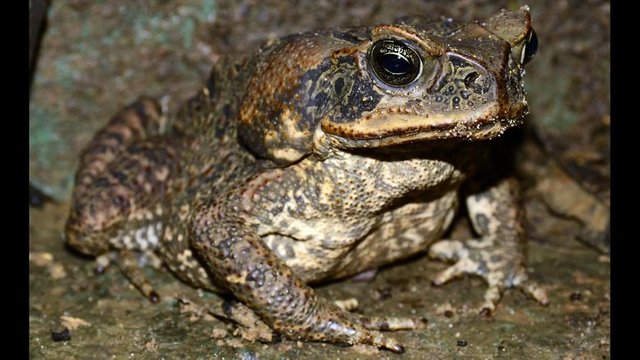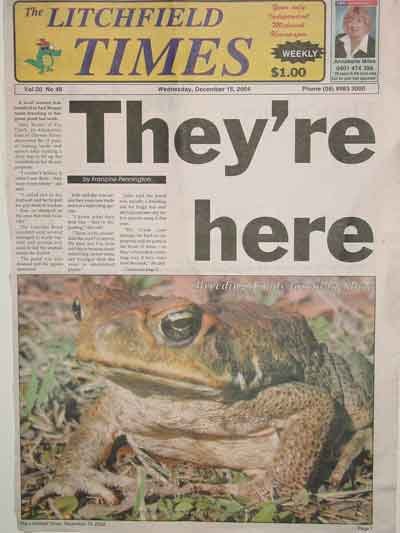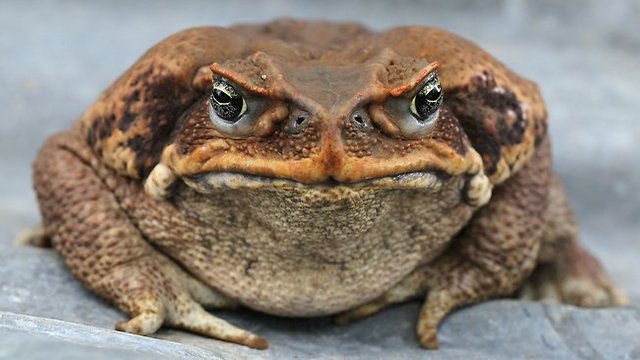The Solution to the Cane Toad Invasion is...MORE TOADS?!?
It all began with good intentions, but we all know what the road to hell is paved with. 80 years ago in Australia, cane farmers were at their wits end; their crops were being ravaged by two species of crop-eating beetles, the frenchi beetle and the greyback beetle. Because the livelihoods of these farmers depended on the success of their crops, the beetles were having a profound impact on the local economy. This prompted the Queensland Department of Agriculture began investigating possible solutions to the problem to aid the farmers. Pesticides were quickly ruled out because those commercially available were still very nasty chemicals (this is still before the fiasco surrounding DDT), so the government began searching for less destructive means of population control. One man, an agricultural scientist by the name of Reginald Mungomery proposed a unique strategy: the introduction of cane toads would curb the beetle population.

That toad is fueled by dreams of a toad-pocalypse.
At the time, it seemed like a reasonable idea. Reports originating from Hawaii were showing an increased sugar cane yield, attributed to the cane toads for feeding on destructive beetles. Convinced the plan would yield nothing but success, Mungomery set his plan into motion; he began breeding cane toads and releasing them in sugar cane fields around Cairns. But what he really set into motion was to become one of the greatest ecological disasters in history. The giant poisonous toads did very little to curb the beetle population, instead setting their hungry sights on other native species; it wasn't long before their numbers grew beyond any form of control and they began their relentless invasion of the Australian continent. The 102 toads originally released by Mungomery sparked a wildfire, and today their numbers are estimated to be more than 1.5 billion. The decision Reginald Mungomery made in 1935 has been condemned internationally ever since.

Today, the toads have taken over 86,000 square miles (1 million square kilometers) of Australia (about the size of Texas and Oklahoma combined! [Source]). All attempts to control the population or slow their relentless march have been met with almost overwhelming failure. The toads seem to thrive even with all the additional pressures imposed by humans; many mayors encourage the killing of these toads because they have become such a blight on the country's natural resources. While some people do feel sorry for these animals...
"It's not their fault; they were brought in against their will. They're just doing what they're good at, which is thriving and multiplying." -Director Mark Lewis Source
...most Australians despise them as the extreme threat they represent. But no matter how many are killed, their population only grows; they have an incredible reproductive drive and females can lay up to 30,000 eggs at a time. Because of their poisonous secretions, they have no predators and face little environmental pressure. In the War on Toads, we seem to be losing.

Rick Shine, a biologist who has devoted much of his life to fighting the cane toad problem (he was the recipient of the 2016 Prime Minister's Prize for Science for his contributions [source]), believes he may have a solution to the invasion.
I am proposing that we can fix Mungomery’s historic blunder by doing almost exactly what he did. -Shine Source
The proposed idea is to introduce juvenile toads along the invasion front to mitigate the destructive impact on local wildlife as the invasion moves on. It sounds like an absolutely terrible idea, however when put into practice, the system seems to work wonders and has already been adopted by (initially skeptical) management authorities and private land owners. The video below explains why the process works.
When cane toads arrive in a new area, predator populations (such as quolls, goannas, bluetongue skinks and snakes) show up to a 95% mortality rate. The reason for such high fatalities is due to two reasons; first, these animals are not the natural predators of the toads, and they do not know that the poison can be lethal when consumed. Second, the advancing front of toads is made up by large adults that are spreading out to colonize and breed (females with eggs and young toads don't move as quickly as the "vanguard toads"). When these large toads arrive, local predators eat them and are killed by the potent toxins. Breeding doesn't usually occur in an area until about a year or so after the initial toad invasion; by the time younger toads appear on the scene, most predators have been wiped out.

Shine theorized that native species would likely stand a fighting chance if the first toads they encountered were juveniles instead of full grown adults. If a predator eats a large toad, it will likely die; however, if a predator eats a young toad (with weaker poison) it will simply get very sick and survive. The bad experience is enough to teach that animal to avoid the cane toad. The predator species can then coexist alongside the invasive toads; as long as they don't try to eat them, they should be relatively okay (there will still be increased competition, but at least the predators have a fighting chance). Shine and his colleague trialled the method and were met with overwhelming success. Working with Northern Quolls, Bluetongue Skinks, and Yellow-spotted Goannas, Shine found that ALL predators that were trained to avoid the toads were still alive 18 months later, whereas ALL the predators who were not trained had perished.

Saving the initial generation of predators might seem like we are just delaying the inevitable. However, when it comes time for these predators to reproduce, the cane toads will be reproducing as well. Young predators will only be able to hunt small prey, and will be incapable of eating the large, lethal adult toads. They will naturally follow the path of their parents, consuming small toads, becoming temporarily ill and learning a valuable lesson about this invasive killer.
All we need is a single generation of education to provide a long-lasting benefit. -Shine Source
Shine's strategy may seem to hamper progress, but the reasoning is sound. While we are introducing more toads to the environment, the invasion of the toads is already pretty much unstoppable. Since we can't seem to hamper their progressive spread, this new practice can at least mitigate their damage to native populations, and perhaps save the animal populations of Australia. Western Australia’s Department of Parks and Wildlife are now working to fine-tune the plan before they put it into action on a landscape scale.

It might seem like another stupid idea, but the evidence seems to suggest that two wrongs could perhaps make a right in this scenario. Stopping the invasion outright is likely a lost cause; perhaps it is best to think outside the box and look to protect the native species as best we can. Perhaps if we can save the native species, one predator might eventually develop a resistance to the poison as act as a predatory pressure. In any case, this may prove to be a turning point in the war against the cane toad.
Video Link: 1
Article Link: https://theconversation.com/

l am fascinated by these examples because it Shows the consequences of messing with complex systems using mechanistic thinking.
I am more and more interested in complexity theory and systems thinking sounds like these guys could've used a dose !
Your content has been chosen as the #2 featured on science-trail's weekly newsletter, congratulations!!
Join us on the science-trail Discord.
That's pretty cool! Thanks!
Great article, I think is a good example of how much do we ignore yet about our planet and show that human should be very cautious at modifying the planet.
I hope they can fix this problem in a natural good way where everybody wins.
I do not understand how making other species surviving will slow down the toad invasion. At some point they will just be everywhere, won't they?
Yes that's true. The problem is that so far we haven't really had any success stopping the spread or even slowing them down. At the rate they are spreading, there might not be much we can do. But if we can save the native species, then the invasion will at least be far less damaging. It's not a perfect solution, but if we are going to be stuck with the toads, at least we have a way to protect Australia's wildlife.
Even if the toads DO spread to the entire continent (which is looking more and more likely) at least we won't be seeing the loss of the native species that we have been witnessing so far.
I see. Thanks for the answer. It is interesting to note that despite the fact the toads are totally changing the ecosystem, they are not slowed down. This looks like ... humans...
great interresting post !